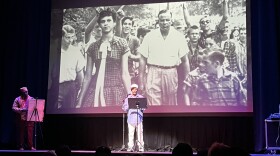-
A ceremony was held in Rock Hill on Thursday night to recognize three African Americans who played a key role in integrating baseball in the South in the 1950s.
-
A ceremony occurred in Charlotte Wednesday that celebrated the transfer of land where newly freed slaves built a church and cemetery. The consecrated land has now returned to their descendants and others with ties to the church.
-
It's been 70 years since Emmett Till, a Black teenager visiting relatives in Mississippi, was killed by white men because he whistled at a white woman. Now the gun used in his death is in a museum.
-
June is Anti-Lynching Month in North Carolina. The Charlotte Post published a series on Willie McDaniel, a Black man lynched in Charlotte in 1929. Freelance journalist Helen Schwab, who wrote the series, spoke with WFAE’s Gwendolyn Glenn about why his story still matters.
-
A new commemorative marker was installed today in one of Charlotte’s Corridors of Opportunity. The marker aims to tell the history of places and people that helped shape the community.
-
A commemorative ceremony over the weekend in Charlotte, hosted by Mecklenburg County, paid tribute to a historic home and the community it represents.
-
This week, WFAE's Marshall Terry and WRAL's Paul Specht evaluate a claim by Rep. Marcia Morey related to Black History Month and Google Calendar.
-
A group of local poets came together Friday night to perform a spoken-word album highlighting Charlotte’s Black history. Their pieces celebrated, honored and spotlighted key moments in the city's past.
-
Some scholars say legislative efforts to limit discussion of race in classrooms across the country underscore the need to make sure local Black history is taught and remembered.
-
While the Siloam School will stand for years to come, many other notable Black sites in Charlotte have been lost, often to development. These buildings, including Good Samaritan Hospital and the Brooklyn neighborhood, also constitute interesting and important aspects of the history of Charlotte’s Black community.
Play Live Radio
Next Up:
0:00
0:00
Available On Air Stations










